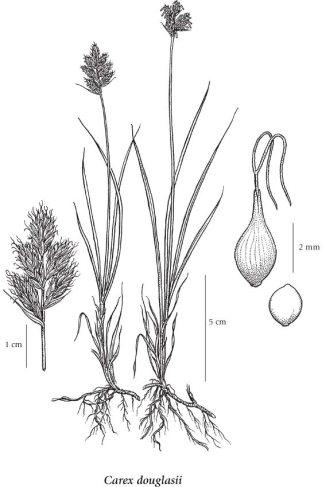Carex douglasii Boott
Douglas' sedge
Cyperaceae (Sedge family)
Introduction to Vascular Plants
Douglas' sedge
Cyperaceae (Sedge family)
Introduction to Vascular Plants
Species Information
General:
Perennial herb from slender, long-creeping rhizomes; stems 10-30 (40) cm tall, arising singly or a few together or sometimes matted, usually exceeding the leaves.
Leaves:
Sheaths tight, brownish or blackish at the bases; blades 3 to 8 per stem, in-rolled on the uppersides or sometimes flat, gradually tapering to the tips, 1-2.5 mm wide.
Flowers:
Spikes usually either male or female on separate plants, the male inflorescence with many aggregated spikes in a narrowly cylindrical to broadly egg-shaped head, the female inflorescence with many aggregated, but distinguishable, spikes in a cylindrical to nearly globe-shaped head, 1.5-5 cm long, unstalked; bracts of the lowest spike leaflike and longer than the spike, those above reduced and much like the scales.
Fruits:
Perigynia narrowly egg-shaped, 3.5-4.5 mm long, 1.6-1.9 mm wide, straw-coloured to brownish, smooth, obscurely many-nerved, crowded, erect, unstalked, the beaks bidentate, 1-1.5 mm long, finely toothed; female scales lanceolate, straw-coloured to light brown, with translucent margins and green centres, wider and longer than the perigynia; stigmas 2; achenes lens-shaped, 1.7-1.8 mm long.
Illustration

If more than one illustration is available for a species (e.g., separate illustrations were provided for two subspecies) then links to the separate images will be provided below. Note that individual subspecies or varietal illustrations are not always available.
Illustration Source: The Illustrated Flora of British Columbia
USDA Species Characteristics
Flower Colour:
Green
Blooming Period:
Late Spring
Fruit/Seed characteristics:
Colour: Brown
Present over the Summer
Source: The USDA
Ecology
Ecological Framework for Carex douglasii
The table below shows the species-specific information calculated from
original data (BEC database) provided by the BC Ministry of Forests and Range.
(Updated August, 2013)
The table below shows the species-specific information calculated from
original data (BEC database) provided by the BC Ministry of Forests and Range.
(Updated August, 2013)
| Site Information |
Value / Class |
||
|
Avg |
Min |
Max |
|
| Elevation
(metres) |
916 | 537 | 1450 |
| Slope
Gradient (%) |
3 | 0 | 22 |
|
Aspect (degrees) |
77 | 150 | 360 |
| Soil
Moisture Regime (SMR) [0 - very xeric; 4 - mesic; 8 - hydric] |
5 | 1 | 8 |
| Modal
Nutrient Regime
Class |
D | ||
| #
of field plots species was recorded in: |
11 | ||
| Modal
BEC Zone Class |
SBS | ||
|
All BEC Zones (# of stations/zone) species was recorded in |
BG(1), BWBS(1), IDF(1), PP(1), SBPS(1), SBS(1) | ||
|
Source:
Klinkenberg 2013
|
|||